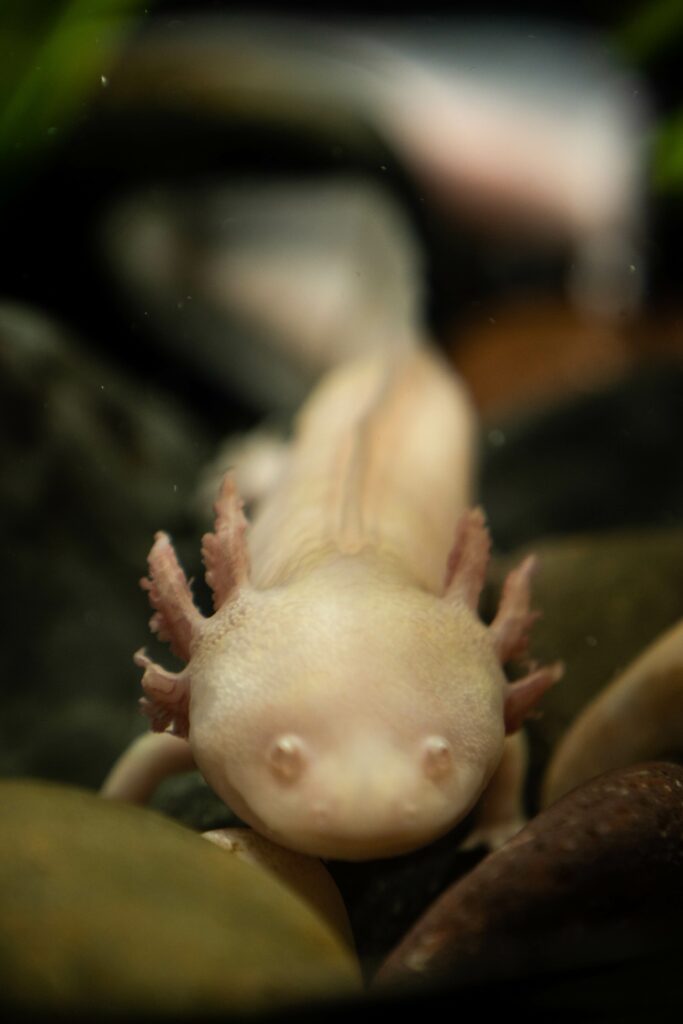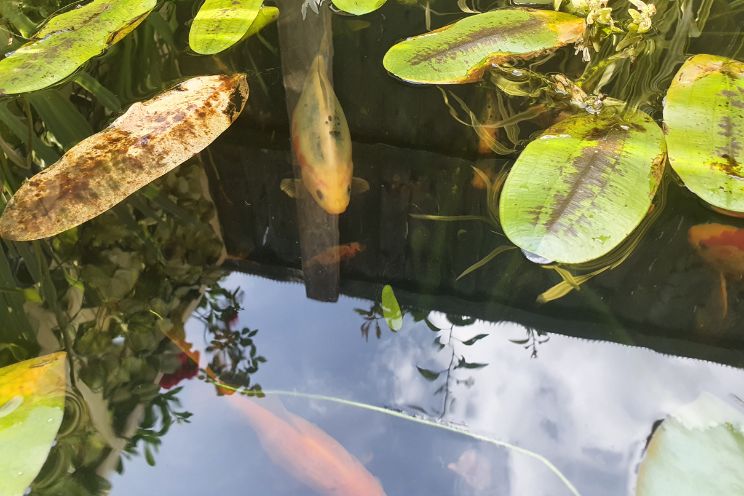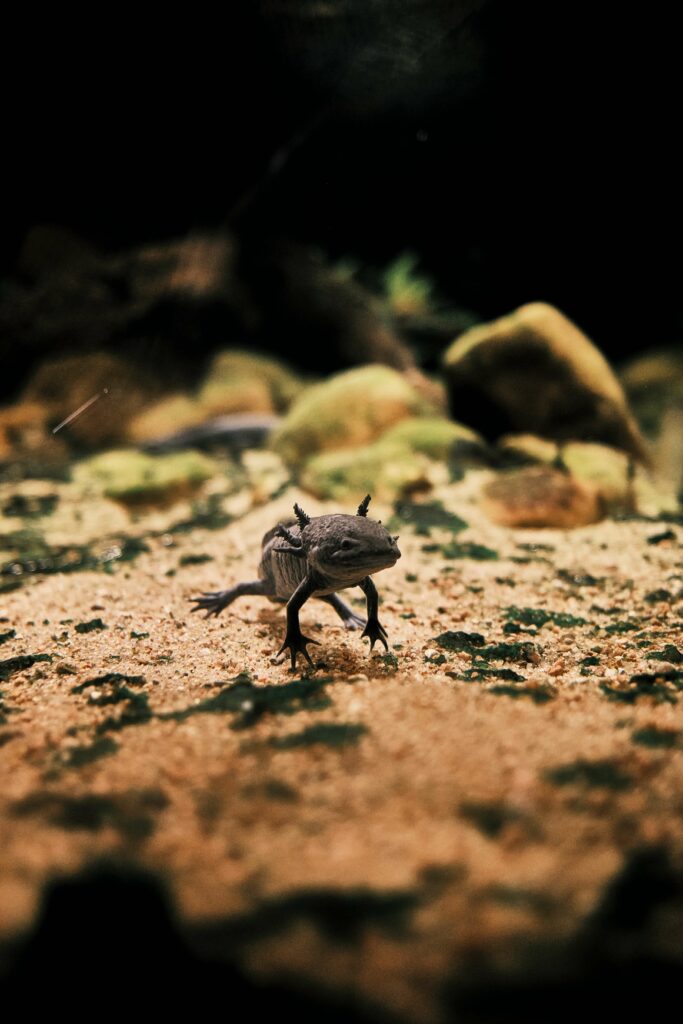Axolotls and goldfish are popular pets, especially with kids, so you might wonder if you can keep them together.
Both species live in cold water, are peaceful, and share similar living conditions. However, we don’t recommend keeping Axolotls and goldfish in the same tank or pond.
Read this guide to find out why you shouldn’t keep an Axolotl with your goldfish.
What are Axolotls?

Before we dive into why you can’t safely keep Goldfish and Axolotls together, you need to know more about Axolotls.
Unlike goldfish that quickly develop from fry into fully-formed miniature adults, Axolotls never leave their larval life stage.
Axolotls are not fish, but neotenic animals, closely related to the tiger salamander. In fact, the larvae of both species are almost identical, but for the fact that the Axolotl almost never morphs into a land salamander, unlike the Tiger salamander.
Neotonic animals can achieve sexual maturity while still in the larval life stage. So, an Axolotl can breed while still in larval form; amazing!

Origins of axolotls
Goldfish are pretty hardy creatures descended from wild Prussian carp. The fish can tolerate a range of water conditions without coming to much harm, which means you can keep them with a variety of fish, invertebrates and other creatures in both tanks and ponds.
However, Axolotls come only from Lake Xochimilco in Mexico and don’t exist anywhere else in the wild. For that reason, these creatures have a narrow window of environmental conditions in which they can survive, some of which are incompatible with goldfish.
Can Axolotls live in a fish tank?
Goldfish and Axolotls can both live in fish tanks.
A tank must hold at least 15 gallons to accommodate one adult Axolotl, and if you want to keep two of these weird-looking creatures, you’ll need at least a 55-gallon tank.
Can Axolotls live in a pond?

Goldfish of most varieties can live in outdoor ponds, and Axolotls originate from a lake, so could the two species share a pond?
Technically, if you replicate Axolotl’s preferred conditions, you could keep them in an outdoor pond. The main issue is keeping the environment safe for the Axolotls and maintaining it.
Axolotls are cold water creatures, like goldfish, requiring a water temperature between 60oF and 67oF. So, if you live in a region where the summers are hot and the winter months see your pond frozen, that might mean an outdoor pond won’t be suitable for an Axolotl without some form of intervention, such as shade, heating, etc.
Temperature changes are major stressors on Axolotls, so you might struggle to provide the environment your pets need unless you enjoy mild winters and summers in your area.

Sensitive Creatures
Despite being fully aquatic, Axolotls are weak animals and poor swimmers, preferring to push themselves slowly around the environment floor. So, if the current generated by your pond filter is too strong, the creatures will struggle to get around, making them highly stressed.
You can’t keep goldfish in a pond without a filter because they generate so much waste. So, there’s clearly going to be a problem when it comes to water flow and compatibility between the two species.
Similarly, if your garden is exposed to high winds, the surface disturbance will almost certainly stress the Axolotls, whereas the oxygen-hungry goldfish will love it!
Most people tend to keep large, slim-bodied goldfish species in outdoor ponds, such as Shubunkins and Comets, together with Koi carp. These large fish are fast, powerful swimmers and could stress the Axolotls by bumping into them or even trying to eat them.
Predators
Because they live in an underground lake, wild Axolotls have no natural predators. However, the creatures could become a meal for birds and predatory mammals in a garden pond.
Do Axolotls eat goldfish?
If you have very small juvenile goldfish, it’s possible that the Axolotls will attempt to eat them. That will stress and potentially injure the goldfish, leading to disease outbreaks and even death.
Do goldfish harm Axolotls?
Although a fully-grown goldfish couldn’t physically eat an adult Axolotl, the fish tend to nip at and worry the Axolotls gills and fins, stressing and potentially injuring your amphibious pet. In addition, although the gills will regrow if damaged, the process is very slow, and the animal could quickly suffocate.
Goldfish are notorious waste producers, which, combined with the mess made by Axolotls, creates a huge burden for your filtration system, a potentially toxic environment for your pets and masses of extra maintenance work for you.

What type of goldfish could live with Axolotls?

The Fancy goldfish is the only goldfish type that might work with an Axolotl. Fancies are slow swimmers, so they would be less likely to hassle the Axolotl, although we still don’t recommend combining the two species.
Tank conditions
If you did decide to try keeping Fancy goldfish and Axolotls together, do they share the same habitat requirements?
Tank size
Fancy goldfish and Axolotls need a tank of at least 15 gallons for one specimen. However, since goldfish should never be kept alone, you’ll need a larger aquarium than that to house both species comfortably.
Water type
Both goldfish and Axolotls are freshwater species, so they are compatible in that respect. Both creatures are vulnerable to the effects of chlorine and chloramine in tap water, so you’ll need to use a water dechlorinator product to make the water safe for your pets.
Goldfish are highly sensitive to ammonia and nitrites, so the levels of these chemicals in the tank must always be zero, while nitrates should be 20 ppm or lower. Axolotls require zero levels of all three of those chemicals.
Given that goldfish produce vast amounts of waste, nitrates in the tank will likely be too high for the Axolotls, regardless of how diligent you are with aquarium maintenance.
Filtration
Axolotls do well with a sponge filter system and minimal flow. In contrast, goldfish need a powerful filtration system that generates good water movement and high dissolved oxygen levels.
Lighting
Goldfish need a regular day/night lighting cycle to remain healthy. If the fish are kept in the dark, their feeding and resting cycles are disturbed, leading to stress and poor health.
However, Axolotls are nocturnal and do best when kept in a dimly lit environment.
Water temperature
Both these species live in cold water. However, Axolotls need a temperature of between 60o and 65o F, whereas Fancy goldfish prefer slightly warmer conditions of 68o to 74o F.
Axolotls need a pH of 7.4 to 7.6, while goldfish prefer a slightly more acidic environment between 6.5 and 7.5, so there is some overlap there.
Tank mates
Axolotls are solitary, although you can usually safely keep a male and female pair together. Although these creatures cannot live with goldfish, they can share a tank with small schooling fish, such as White Cloud Mountain Minnows, Zebra danios, and Mosquito fish. Apple snails can also make good tank mates for Axolotls.
Fancy goldfish do best when kept with other Fancies, although they can also share a tank with White Cloud Mountain Minnows, Zebra danios, and Mosquito fish.
Like Axolotls, you can’t keep Fancy goldfish with long-bodied varieties. The slower Fancies will be outcompeted for food and stressed by the bumping and barging that typically occurs during a goldfish feeding frenzy.
Diet and feeding
Essentially, you can feed Axolotls and Fancy goldfish a similar diet of pellets and frozen meaty foods, such as bloodworms, mosquito larvae, daphnia, etc.
However, since Axolotls are nocturnal, and goldfish are active during the daytime, you would need to work out two separate feeding schedules so that neither species goes hungry.

Final Thoughts
Did you enjoy our guide to keeping Axolotls and goldfish together? If you did, please remember to share the article before you go!
Axolotls and goldfish cannot be kept together as tank mates or in a fish tank. The creatures require different basic living conditions and water parameters, and goldfish could stress and injure the Axolotls by nipping at their tails and gills.
If you keep Axolotls, what tank mates do they have? Tell us about your pets in the comments box below.

I’m not implying that the information stated above is possibly incorrect, false or untrue in a indoor aquarium setting, mainly because I don’t have one of those. However, the statement of,
“Axolotls and goldfish cannot be kept together as tank mates or in a fish tank. The creatures require different basic living conditions and water parameters, and goldfish could stress and injure the Axolotls by nipping at their tails and gills” would definately be incorrect information for a outdoor pond/water feature.
I can back up my claim through past and current visual observations of my 4 oversized Goldfish, and the 15ish completely non-domesticated/wild Axolotls that decided to call my backyard water feature and the small incorporated 12’L×6’Wx14-18″D pond their home. Granted, over the last 8 years since the Axolotls originally first mysteriously/randomly appeared in my backyard, their for sure have been several generations that have come and gone, and have been living in my backyard pond.
My whole point to this is that in my situation and from my daily actual observations, I am going to say that In Fact, You Can have both species living together amicably in the same body of water with no issues or conflict between them. The Axolotls mysteriously appeared and moved in with the fish that already lived there for at least 2 years before ever seeing a Axolotls. For some reason they don’t bug each other, neither one messes with the others babies either.
I’m no expert and I have no Phd or any other specialized fancy worded edumacation titles to put in front of, or anywhere near my name. I just have the facts I can see and record and happily share any evidence of proof needed in my claims.
They can live together in the same location with no problem in the correct habitat, if they want to.
Thank you very much for your very helpful article.
I have been working in an aquarium shop part time and needed to know this information so I can help customers.
Kindest regards,
Trish